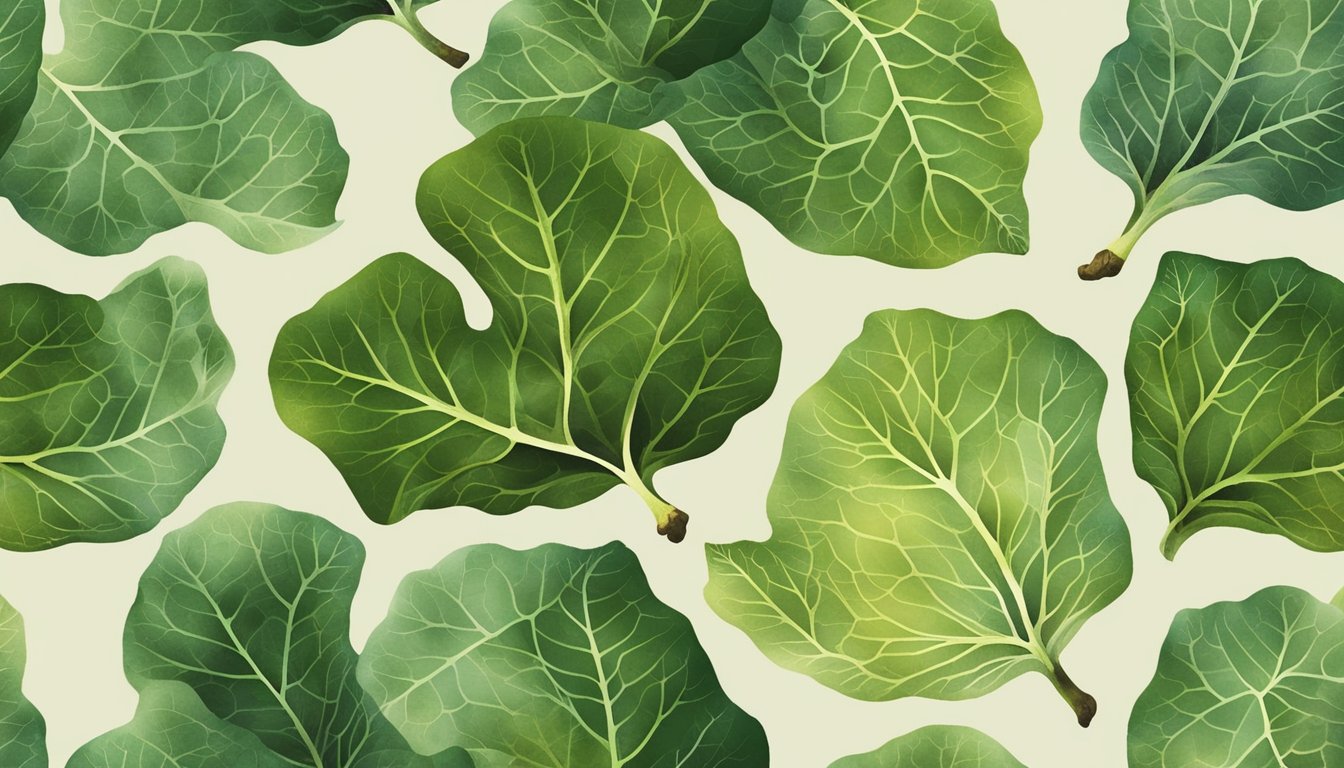Fig leaves might not be the first thing that comes to mind when you think of superfoods or natural remedies, but they’re a hidden gem waiting to be discovered. I’ve delved into the incredible benefits these leaves offer, from their rich nutrient profile to their surprising versatility in the kitchen and beyond.
Imagine tapping into a natural source of antioxidants and essential vitamins while adding a unique flavor to your dishes. Whether you’re looking to boost your health or elevate your culinary creations, harnessing the power of fig leaves could be your next best move. Let’s explore how these often-overlooked leaves can transform your wellness routine and culinary adventures.
Harnessing The Power Of Fig Leaves
Harnessing the power of fig leaves can transform your health and cooking. These leaves boast a treasure trove of nutrients. They’re low in calories and high in fiber, making them a great addition to any diet. Antioxidants found in fig leaves help combat oxidative stress, keeping cells healthy.
I enjoy using fig leaves in various dishes. They add a unique flavor to salads, stews, and wraps. Try wrapping grilled fish or chicken in fig leaves before cooking. This method locks in moisture and infuses a subtle sweetness.
People often overlook the health benefits of fig leaves. They may help regulate blood sugar levels, which is great for managing weight. The leaves contain beneficial compounds that can support heart health too.
Think of fig leaves as your new secret ingredient. They can elevate everyday meals without much effort. Dried fig leaves make a tasty tea. Simply steep them in hot water for a soothing drink.
Consider using fig leaves when you cook. Their versatility can surprise you. Whether you decide to sauté or brew, you’ll find countless ways to enjoy their benefits. Just remember, nature’s treasures often lie in plain sight.
Nutritional Benefits – Harnessing the Power of Fig Leaves

Fig leaves pack a punch when it comes to nutrition. These leaves are not just for decoration; they’re powerhouses of vitamins and minerals.
Vitamins And Minerals
Fig leaves contain vitamin A, which supports vision and skin health. They also provide vitamin C, aiding in immune function and collagen production. Calcium and magnesium present in fig leaves help maintain strong bones and regulate muscle function. Iron boosts red blood cell production, which is especially important for energy. Plus, the fiber content supports digestion, keeping my gut happy. Who knew a leaf could be so nutrient-dense?
Antioxidant Properties
Antioxidants are crucial in fighting free radicals, and fig leaves are loaded with them. They boast compounds like polyphenols and flavonoids. These compounds work to reduce oxidative stress, which can lead to chronic diseases. By including fig leaves in my meals, I give my body an antioxidant boost. This tasty addition not only enhances flavor but also supports my health with every bite. Who doesn’t love food that does double duty?
Traditional Uses – Harnessing the Power of Fig Leaves
Fig leaves serve as a valuable resource in various traditional practices. These leaves have earned their place in both medicinal and culinary contexts, thanks to their unique properties.
Medicinal Applications
I often rely on fig leaves for their natural healing benefits. Traditionally, people have used fig leaves to help manage diabetes. Research indicates that compounds in the leaves can lower blood sugar levels. I’ve also read about their role in promoting digestive health. A tea made from dried fig leaves can soothe an upset stomach and calm bloating. Moreover, some cultures apply fig leaf poultices to the skin to treat minor wounds and inflammation. It’s fascinating how folklore sometimes mirrors scientific findings!
Culinary Uses
In the kitchen, fig leaves shine in various recipes. I love wrapping fish or chicken in fig leaves before grilling. The leaves add a subtle flavor and keep the meat moist,a real game-changer! People often use fig leaves in salads for a fresh, slightly herbal taste. Some even bake with them, using the leaves to line bread pans or to infuse sweetness into desserts. I’ve tried fig leaf tea, and it’s surprisingly pleasant,like a warm hug in a cup. It’s amazing how these often-overlooked leaves can elevate dishes and add depth to meals.
Modern Research – Harnessing the Power of Fig Leaves

Fig leaves are gaining attention in modern research for their impressive health benefits. Studies show that these leaves contain bioactive compounds with promising properties.
Scientific Studies
Recent research highlights the anti-diabetic effects of fig leaves. One study found that fig leaf extract helped lower blood sugar levels in diabetic rats. Another study focused on antioxidants in fig leaves. It revealed that these antioxidants combat oxidative stress. Laboratory tests confirmed that fig leaf compounds can reduce inflammation. Researchers also discovered potential antibacterial properties, which could enhance our immune responses.
Health Claims
Health claims about fig leaves are backed by science. People often tout their ability to aid digestion. High fiber content plays a role in this benefit. Several studies suggest that fig leaves may support heart health. Their rich nutrient profile includes vitamins and minerals that promote overall well-being. Many individuals also use fig leaves for skin health. Topical applications of fig leaf extracts are said to soothe irritations. This versatile plant proves to be more than just an ornamental addition to the garden; it’s a powerhouse of nutrients worth exploring.
Sustainable Practices – Harnessing the Power of Fig Leaves
Sustainable practices in fig leaf cultivation promote health and environmental well-being. Fig trees thrive in warm climates. I learned that planting them in well-drained soil boosts growth. Organic farming methods, such as natural pest control, ensure clean produce. This helps keep both the land and me healthy.
Cultivation Methods
I prefer growing fig trees organically. This means using no synthetic fertilizers or pesticides. Instead, I rely on compost and natural fertilizers. These options enhance soil health and produce nutrient-rich leaves. I also focus on crop rotation. This practice prevents soil depletion and promotes better yields.
I often plant fig trees in strategic locations. They benefit from sunlight while providing shade for nearby plants. This approach maximizes space and nurtures a diverse garden. I’d recommend pruning fig trees annually. It encourages better airflow, reduces disease, and keeps the plants manageable.
Environmental Impact
Using fig leaves has a positive environmental impact. Fig trees capture carbon dioxide, helping to fight climate change. I find that local sourcing of fig leaves reduces transportation emissions. Using them in my cooking also minimizes waste. For example, I create delicious dishes using both leaves and fruit.
Moreover, these trees support local wildlife. Birds and insects rely on them for food and habitat. My garden feels alive with activity, thanks to the fig ecosystem. Adopting fig leaves in my diet promotes biodiversity. Eating seasonal produce like this can benefit both our health and the planet.
Sustainable practices with fig leaves create a symbiotic relationship between our plates and the environment. With each bite, I contribute not just to my health but to a greener world.
Before You Go – Harnessing the Power of Fig Leaves
Embracing fig leaves in my diet has truly opened up a world of culinary and health benefits. Their unique flavor and impressive nutrient profile make them a fantastic addition to everyday meals. I’ve found that not only do they enhance dishes but they also support my wellness goals.
By incorporating these versatile leaves into my cooking, I’m not just enjoying delicious meals but also contributing to a healthier lifestyle. Plus, knowing that my choices can positively impact the environment makes it even more rewarding. I encourage you to explore fig leaves and discover how they can transform your kitchen and well-being. Don’t forget to add The Herb Prof to your favorites so you don’t miss out on future articles.
References – Harnessing the Power of Fig Leaves
Little Herb Encyclopedia, by Jack Ritchason; N.D., Woodland Publishing Incorporated, 1995
The Ultimate Healing System, Course Manual, Copyright 1985, Don Lepore
Planetary Herbology, Michael Tierra, C.A., N.D., Lotus Press, 1988
Handbook of Medicinal Herbs, by James A. Duke, Pub. CRP Second Edition 2007
The Complete Medicinal Herbal, by Penelope Ody, Published by Dorling Kindersley
Check the Following Articles
Callisia Repens: The Perfect Low-Maintenance Houseplant
Oolong Caffeine: The Ultra Guide
Snake Repellent Plants to Keep Your Yard & House Safe
Does White Tea Have Caffeine? The Truth
Frequently Asked Questions – Harnessing the Power of Fig Leaves
What are the health benefits of fig leaves?
Fig leaves are packed with antioxidants, vitamins, and minerals, promoting overall health. They may help regulate blood sugar levels, support heart health, and aid digestion due to their high fiber content. Their antioxidant properties reduce oxidative stress and inflammation, making them a valuable addition to your diet.
How can I incorporate fig leaves into my cooking?
Fig leaves can be used in various ways in the kitchen. They are excellent for wrapping grilled fish or chicken, adding moisture and flavor. You can also chop them into salads, use them in stews, or bake with them for unique desserts. Dried fig leaves can be steeped to make soothing tea.
Are fig leaves a good source of nutrients?
Yes, fig leaves are rich in essential nutrients. They provide vitamin A for eye and skin health, vitamin C for the immune system, and important minerals like calcium, magnesium, and iron, which are vital for strong bones and energy levels. Their high fiber content also supports digestive health.
Can fig leaves help with diabetes?
Research suggests that fig leaves can have anti-diabetic effects, potentially helping to lower blood sugar levels. Some studies indicate that extracts of fig leaves might improve insulin sensitivity, making them a beneficial dietary addition for those managing diabetes.
How do fig leaves impact the environment?
Fig trees play a role in environmental sustainability by capturing carbon dioxide and supporting local wildlife. Sourcing fig leaves locally can reduce transportation emissions, and organic farming methods enhance soil health, creating a positive impact on both personal health and the environment.
What are traditional uses of fig leaves?
Traditionally, fig leaves have been used for both culinary and medicinal purposes. They are known to soothe digestive issues when brewed into tea and can be applied as poultices for minor wounds. In cooking, fig leaves add unique flavors to dishes and enhance moisture in proteins.
Are fig leaves low in calories?
Yes, fig leaves are low in calories, making them an excellent addition to a healthy diet. Their high fiber content helps keep you full while providing essential nutrients without excessive calorie intake, supporting weight management and overall wellness.

